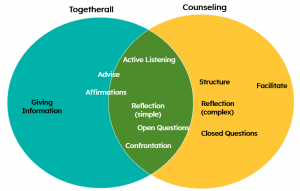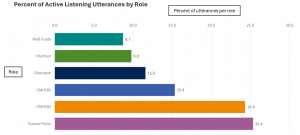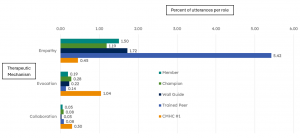Digital peer support works; but how and why? Lyssn, an impartial third party, performed a rigorous evaluation of Togetherall’s community, and here’s what they found

March 13 2024
Peer support: we as human beings depend on it every day, but sometimes it’s hard to find what you need in-the-moment. Sometimes those closest to us aren’t the best ones to confide in when we’re going through certain struggles, or the right people aren’t available at the right time. Sometimes, you really need people who are part of your specific communities, such as college students, agricultural workers, caretakers, healthcare personnel, or other groups who can really relate with shared lived experiences.
This is why Togetherall was created: so that communities of people can have access to a safe, online space where they can connect with one another anonymously and support each other through everyday mental health challenges. And it WORKS.
How and why it works is why we’re here today. We entrusted Lyssn, an impartial third party, to rigorously evaluate our digital peer support community. This is what Lyssn does: they use state-of-the-art AI to perform analyses on digital mental health services and evaluate clinical conversations. In this case, Lyssn explored how known the therapeutic ingredients of individual counseling appear in Togetherall’s peer-support community. The findings were positive and compelling. Here’s what they found…
The Key Findings: Digital Peer Support is Therapeutic
Togetherall’s Chief Clinical Officer, Ben Locke, Ph.D., worked closely with Lyssn’s Chief Science Officer, Zac Imel, Ph.D., to examine our online peer-to-peer community and better understand the therapeutic/active ingredients across conversations and participants.
To explore whether peer support in the Togetherall community contains known therapeutic qualities, Lyssn’s AI models examined more than 5.7 million utterances (a complete thought, often a sentence), by nearly 50,000 Togetherall members for matches with their established therapeutic ingredients such as: active listening, giving information, advice, affirmations, questions, facilitation, etc. The prevalence of these therapeutic ingredients was then compared with two known Lyssn benchmarks representing traditional counseling agencies:
- CMHC#1: a large community mental health center
- CMHC#2: a smaller community mental health center, measured after training designed to increase their overall rate of Active Listening.
In addition, we asked Lyssn to dive deeper and examine how the contribution of therapeutic ingredients varied as a function of roles in the Togetherall community:
- Member: peers/seeking offering support
- Champion: top 5% of members in terms of commenting on other member’s posts
- Trained Peer: members of Togetherall who are undergoing, or have undergone, a 10-week, training program on digital peer support delivered and supervised by Togetherall’s clinical Team
- Wall Guide: licensed clinicians who moderate the community
Results indicated that different roles in the Togetherall community contribute variable proportions of therapeutic ingredients. For example, Wall Guides emphasize giving information (structure, information, feedback, referrals, etc.) whereas Trained Peers stand out in their provision of advice, affirmation, and empathy.
Three key takeaways from our study highlight the significance of these findings.
Note: all graphs are out of 100%.
TAKEAWAY #1
Lyssn’s analysis established that Togetherall’s peer support platform contains all of the same therapeutic ingredients observed in traditional mental health services, using CCMH#1 as the benchmark.
In addition, results indicated that Togetherall’s peer-support community is therapeutically distinct from traditional counseling services; i.e., while the two services are substantively similar in many respects, they are also distinct in their therapeutic emphasis. More specifically, whereas traditional counseling is notable for its emphasis on actions such as facilitation, structuring sessions, and providing complex reflections – Togetherall’s peer support community is notable for giving of information (i.e., self-disclosure, sharing lived experiences), advice, and affirmations.
The chart below illustrates how the two services are similar and different in terms of therapeutic mechanisms:

TAKEAWAY #2
Results indicated that the contribution of therapeutic ingredients varies by role in the Togetherall community, showcasing distinct skill sets like affirmation, reflection, and most notably, active listening.
For example, Wall Guides’ contributions tend to be relatively neutral in tone, focused on encouraging participation in the peer community (as opposed to counseling), and emphasize communications such as answering questions, reinforcing house-rules, providing referrals, assessment, checking on safety, etc.
Role-based contributions of active listening were of particular interest in this study because Lyssn’s measurement of active listening incorporates a number of specific therapeutic ingredients and because prior research has found that rates of active listening (by counselor and agency) are associated with positive treatment outcomes, such as retention.
The chart below illustrates the proportion of active listening utterances per role:

Because Togetherall’s peer support is distinct from traditional counseling in many ways (experience, length of interaction, intended outcome goals, etc.), we would not expect the rates of active listening to be the same. However, it’s notable that the community-wide average rate of active listening was 10.2% which provides the first benchmark level of its kind.
Additionally, we can see that very active members (Champions) build on that, and that Trained Peers are delivering an exceptionally high level of active listening. These results broadly confirm the therapeutic nature of the Togetherall community and specifically validate the design and implementation of the Trained Peer program.
TAKEAWAY #3
Building on the last takeaway, a wide range of role comparisons indicate that Togetherall Trained Peers make a consistently distinct therapeutic contribution to the community, which is notable for high levels of therapeutic ingredients such as providing advice, affirmations (validation), notably empathic responses, and overall levels of active listening.
These outcomes validate the theoretical design of the structured 10-week training program and affirm the idea that a peer continuum, stretching from new member to expert peer supporter, is a viable pathway for fostering engagement and providing therapeutic peer support.

Final Thoughts
The most important takeaway from Lyssn’s analysis is that Togetherall’s peer support community has been empirically determined to be therapeutic, i.e., to contain the therapeutic elements found in traditional services. Furthermore, the therapeutic ingredients found to exist in Togetherall are well-established in their relationship to positive treatment outcomes, shedding light on why peer support is effective. While Togetherall’s peer support community is therapeutically similar to traditional counseling, it is also clearly distinct in the therapeutic mechanisms emphasized for those who use it.
The additional findings related to the Trained Peers Program provide striking support for our collective ability to train the next generation of mental health supports in new ways that leverage the benefits of emerging solutions.
In today’s modern realm of mental health offerings where this type of support is only more recently accepted as a formal service, these results are truly groundbreaking and offer empirical support for a more scalable and sustainable future in the provision of mental health supports for populations.
There’s so much more we uncovered in our study with Lyssn, and we’ll be showcasing the myriad of findings in the coming weeks and months.
In the meantime, check out the webinar we held on February 13, 2024, “How and Why Digital Peer Support Works: Unpacking the Groundbreaking New Study by Togetherall and Lyssn”:





